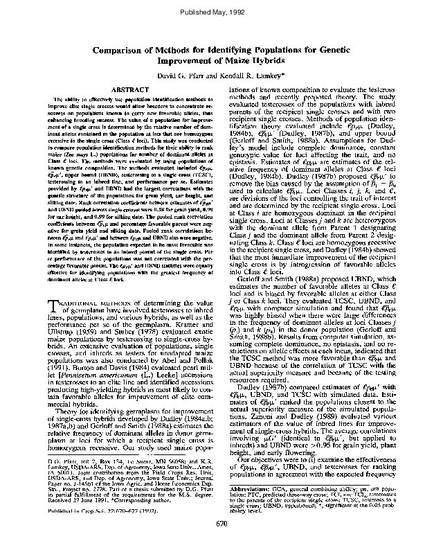
The ability to effectively use population identification methods to improve elite single crosses would allow breeders to concentrate resources on populations known to carry new favorable alleles, thus enhancing breeding success. The value of a population for improvement of a single cross is determined by the relative number of dominant alleles contained in the population at loci that are homozygous recessive in the single cross (Class ℯ loci). This study was conducted to compare population identification methods for their ability to rank maize (Zea mays L.) populations for number of dominant alleles at Class ℯ loci. The methods were evaluated by using populations of known genetic composition. The methods evaluated included , , upper bound (UBND), testcrossing to a single cross (TCSC), testcrossing to an inbred line, and performance per se. Estimates provided by and UBND had the largest correlations with the genetic structure of the populations for grain yield, ear height, and silking date. Rank correlation coefficients between estimates of and UBND pooled across single crosses were 0.98 for grain yield, 0.99 for ear height, and 0.99 for silking date. The pooled rank correlation coefficients between and percentage favorable parent were negative for grain yield and silking date. Pooled rank correlations between and and between and UBND also were negative. In some instances, the population expected to be most favorable was identified by testcrosses to an inbred parent of the single cross. Per se performance of the populations was not correlated with the percentage favorable parent. The and UBND statistics were equally effective for identifying populations with the greatest frequency of dominant alleles at Class ℯ loci.
Available at: http://works.bepress.com/kendall_lamkey/35/

This article is published as Pfarr, David G., and Kendall R. Lamkey. "Comparison of methods for identifying populations for genetic improvement of maize hybrids." Crop science 32, no. 3 (1992): 670-677. doi: 10.2135/cropsci1992.0011183X003200030018x. Posted with permission.